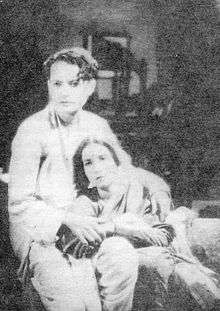Pramathesh Barua
| Prathmesh Barua | |
|---|---|
 Pramathesh Barua and Jamuna Barua in Devdas | |
| Born |
Pramatesh Chandra Barua 24 October 1903 Gauripur, Assam, India |
| Died |
29 November 1951 (aged 48) Calcutta, West Bengal, India |
| Spouse(s) |
Jamuna Barua
Madhuri Lata
|
Pramathesh Chandra Barua (Assamese: প্রমথেশ চন্দ্র বৰুৱা, Bengali: প্রমথেশ চন্দ্র বড়ুয়া) (24 October 1903 – 29 November 1951) was a famous actor, director, and screenwriter of Indian films in the pre-independence era, born in Gauripur.[1]
Early life
Barua was the son of the Zamindar of Gauripur, Assam, where he was born and spent his childhood.[2] He studied at Hare School, Calcutta and then Bachelor of Science graduated from Presidency College, Calcutta in 1924. At the age of only 18, while still studying in college, he got married. It was arranged by the family. He had two more marriages. His third wife was film actress Jamuna Barua. After his graduation, he travelled to Europe, where he received his first exposure to films. After returning, he served for a time in the Assam Legislative Assembly and joined the Swaraj Party but ultimately moved to Calcutta and later began a career in films, much to the chagrin of his father.
Film career
Barua made a small investment in Dhirendra Nath Ganguly's Indo British Film Co, and also worked for him as an actor. He then went to Europe for a second time, observing production of movies in London. After purchasing some lighting equipment in Paris, he returned to India and established Barua Pictures Limited. The studio's first major project was Apradhi in 1931, a silent film that starred Barua and was directed by Debaki Bose. The film became a critical success,[3] and Barua went on to play the villain in Bhagyalaxmi (1932), directed by Dhiren Ganguly. Barua later hired Ganguly when British Dominion Films failed, and the two of them, along with Debaki Bose, then joined New Theatres.
Barua's breakthrough with New Theatres came with Devdas in 1935. The film was first made in Bengali, with Barua himself in the title role; he then remade it in Hindi as the 1936 film Devdas, with K.L. Saigal as the leading man. The Hindi version became a craze all throughout India; it cemented Barua as a top-notch director and Saigal as the top-notch hero of Indian films.The Devdas (Assamese) was Barua's last of three language versions. Barua followed up Devdas with Manzil in 1936, Mukti in 1937, Adhikar in 1938, Rajat Jayanti in 1939, and Zindagi (which reunited him with Saigal) in 1940. Phani Majumdar who later became a noted film director in his own right, started his film career with Barua at New Theatres.[4]
Barua's films were photographed by Bimal Roy, who would later become an accomplished director in his own right.
Barua left New Theatres in 1939 and freelanced thereafter. However, of his post-New Theatres films, only Shesh Uttar/Jawab (1942) stood out. He planned an Indian version of The Way of All Flesh, but it never materialised. He took to drinking heavily, and his health began to decline; he died in 1951.
Filmography

Director
- Bengal 1983 (1932)
- Roop Lekha/Mohabbat Ki Kasauti(1934)
- Devdas (1935)
- Maya (1936/II)
- Maya (1936/I)
- Manzil (1936)
- Grihadah (1936)
- Devdas (1936)
- Devdas (1937)
- Mukti (1937/II)
- Mukti (1937/I)
- Adhikar (1938)
- Rajat Jayanti (1939)
- Adhikar (1939)
- Zindagi (1940)
- Shap Mukti (1940)
- Mayer Pran (1941)
- Uttarayan (1941)
- Jawab (1942)
- Chandar Kalanka (1942)
- Rani (1943)
- Subah Shyam (1944)
- Ameeree (1945)
- Pehchan (1946)
- Iran Ki Ek Raat (1949)
- Maya Kanan (1953)
Actor
- 1. Subah Shyam (1944)
- 2. Rani (1943)
- 3. Jawab (1942) .... Manoj
- 4. Uttarayan (1941) .... Salil
- 5. Mayer Pran (1941) .... Satish
- 6. Shap Mukti (1940) .... Ramesh
- 7. Adhikar (1939) .... Nikhilesh
- 8. Rajat Jayanti (1939) .... Rajat
- 9. Adhikar (1938) .... Nikhilesh
- 10. Mukti (1937/I) .... Prasant
- 11. Mukti (1937/II) .... Prasanta
- 12. Grihadah (1936) .... Mahim
- 13. Manzil (1936) .... Mahim
- 14. Devdas (1935) .... Devdas
- 15. Roop Lekha (1934) .... Arup in the Bengali version
- 16. Bengal 1983 (1932)
- 17. Aparadhi (1931)
- 18. Charitraheen (1931)
- 19. Takay Ki Na Hay (1931)
Writer
- 1. Adhikar (1939) (writer)
- 2. Rajat Jayanti (1939) (writer)
- 3. Adhikar (1938) (writer)
- 4. Mukti (1937/I) (writer)
- 5. Mukti (1937/II) (writer)
- 6. Devdas (1936 film) (writer)
- 7. Maya (1936/I) (writer)
- 8. Maya (1936/II) (writer)
- 9. Devdas (1935 film) (writer)
- 10. Ekada (1932) (screenplay) (story)
Cinematographer
- 1. Zindagi (1940)
References
Notes
- ↑ "Calcuttaweb Cinema – Pramathesh Barua". www.calcuttaweb.com. Retrieved 23 October 2008.
- ↑ Bhanja, Manujendra. "Indian Cinema : The Platinum Touch". www.bfjaawards.com. Archived from the original on 2 May 2008. Retrieved 23 October 2008.
- ↑ Shoma A. Chatterji (1 January 2008). "The Maxing Of A Creative Artist". P.C. Barua. SCB Distributors. p. 43. ISBN 978-81-8328-226-0. Retrieved 4 September 2015.
- ↑ "Obituary: Phani Majumdar". The Independent. 22 June 1994.
- Further reading
- Chatterji, Shoma. P. C. Barua. Delhi: Wisdom Tree. ISBN 978-81-8328-104-1.
External links
- Chatterji, Shoma A. (15 October 2009). "Pramathesh Chandra Barua-The First Star in Bengali Cinema". Calcutta Tube
- P.C. Barua at cinema section of Calcuttaweb.com
- Pramathesh Barua profile, (Bengali)
- Pramathesh Barua at the Internet Movie Database